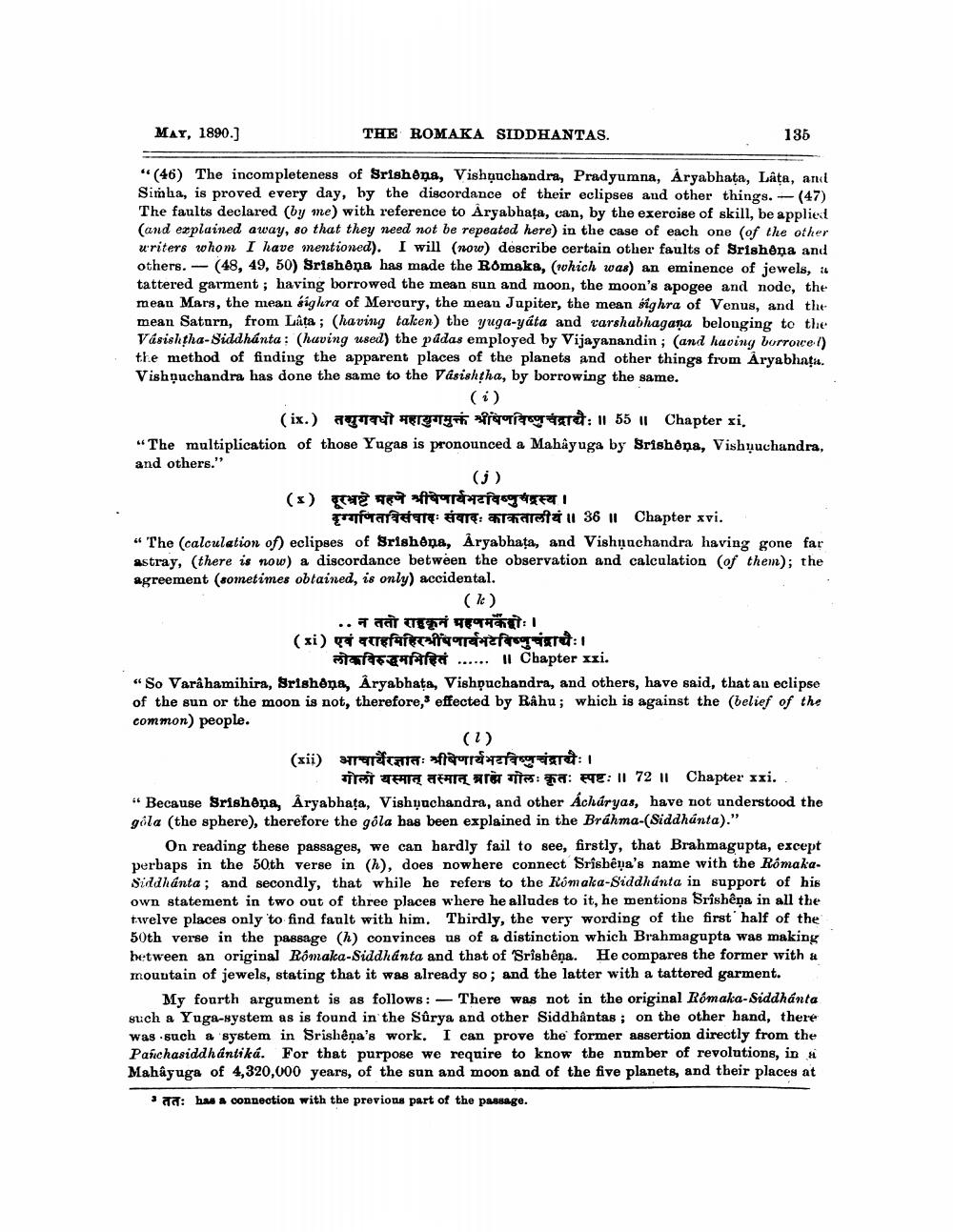________________
MAY, 1890.)
THE ROMAKA SIDDHANTAS.
135
“(46) The incompleteness of Srishóņa, Vishğuchandra, Pradyumna, Aryabhata, Lâța, and Simba, is proved every day, by the discordance of their eclipses and other things. - (47) The faults declared (by me) with reference to Aryabhata, can, by the exercise of skill, be applied (and explained away, so that they need not be repeated here) in the case of each one of the other writers whom I have mentioned). I will (now) describe certain other faults of Srishëna and others. - (48, 49, 50) Srishona has made the Romaka, which was) an eminence of jewels, it tattered garment; having borrowed the mean sun and moon, the moon's apogee and node, the mean Mars, the mean síghra of Mercury, the mean Jupiter, the mean sighra of Venus, and the mean Saturn, from Lata ; (having taken the yuga-yata and varshabhagana belonging to the Vásishtha-Siddhanta: (having used) the pádas employed by Vijayanandin; (and having borrowe() the method of finding the apparent places of the planets and other things from Aryabhata. Vishộuchandra has done the same to the Vâsishtha, by borrowing the same.
(ix.) agtrit Her Ti r e: 55 11 Chapter xi. "The multiplication of those Yugas is pronounced a Mahấyuga by Srishöņa, Vishụuchandra, and others."
(j) (3) EU formefashFUTI
frarara vara: anarete il 36 11 Chapter xvi. • The calculation of eclipses of Srishona, Aryabhata, and Vishạ chandra having gone far astray, (there is now) a discordance between the observation and calculation of them); the agreement (sometimes obtained, is only) accidental.
(k) ..Tacit 95 : 1 (xi) एवं वराहमिहिरीपणार्यभटविष्णुचंद्राचैः।
ata ...... 11 Chapter xxi. “So Varahamihira, Srishona, Aryabhata, Vishịuchandra, and others, have said, that an eclipse of the sun or the moon is not, therefore, effected by Rahu; which is against the (belief of the common people.
(xii) Tata: ferraferard: 1
T TH ATLAITS: : FTE: 11 7211 Chapter xxi. "Because Srishna, Aryabhata, Vishyachandra, and other Achúryas, have not understood the gola (the sphere), therefore the gola has been explained in the Bráhma-(Siddhanta)."
On reading these passages, we can hardly fail to see, firstly, that Brahmagupta, except perbaps in the 50th verse in (h), does nowhere connect Srisbêņa's name with the Romaka. Siddhanta ; and secondly, that while he refers to the Rómaka-Siddhanta in support of his own statement in two out of three places where he alludes to it, he mentiona Srishêņa in all the twelve places only to find fault with him. Thirdly, the very wording of the first half of the 50th verse in the passage (h) convinces us of a distinction which Brahmagupta was making between an original Rômaka-Siddhanta and that of Srishêņa. He compares the former with a mountain of jewels, stating that it was already so; and the latter with a tattered garment.
My fourth argument is as follows:- There was not in the original Rómaka-Siddhanta such a Yuga-system as is found in the Sûrya and other Siddhantas ; on the other hand, there was such a system in Srishêņa's work. I can prove the former assertion directly from the Parchasiddhantiká. For that purpose we require to know the number of revolutions, in a Mahâyuga of 4,320,000 years, of the sun and moon and of the five planets, and their places at
: has a connection with the previous part of the passage.




